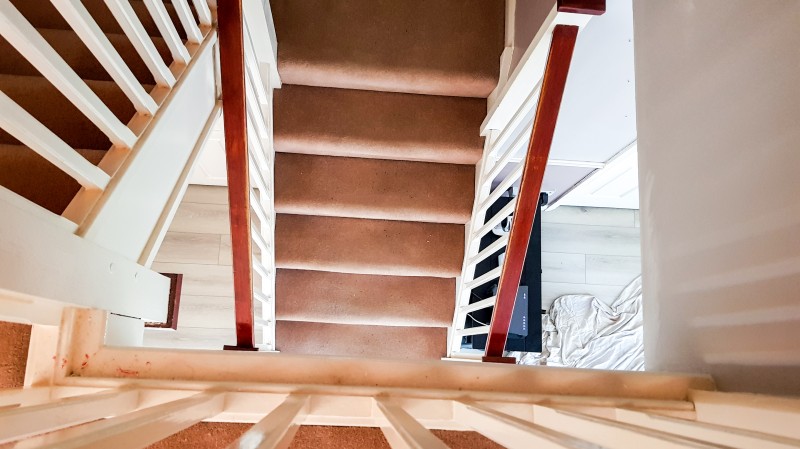You are here: Staircases: design ideas, solutions for small spaces and regulations
Whether you want a showstopping staircase or something simpler to blend in, here are some ideas to inspire you
For many properties, the staircase is often the first feature that greets guests as they walk through the front door. Often a stairwell is the only double-height space in a home. Don’t hide it away, let it shine. Whether you want a showstopping focal point or something more functional, the staircase sets the tone for your home’s décor

Design choices
The classic straight staircase is the simplest and most cost-effective design. And it has the bonus of providing space for an understairs cupboard – or even a work or study area. Add winders or angled, tapered treads to negotiate a change in direction. Alternatively, split the staircase in two and connect with a quarter landing. Timber kits are available from around £450 for 12 risers and a handrail. A bespoke staircase will cost significantly more than a prefabricated one, but it will be custom-made to your specific requirements.
For a lightweight, airy look consider a cantilevered staircase fixed into one wall with treads that appear to float in mid-air. There are also cutting-edge, spiral designs that wind around a hidden steel support.Clever engineering allows the ‘floating’ staircase to become a stunning centrepiece without the need for any structural walls.
Closed vs open riser stairs
When designing staircases,a key design decision is whether to have closed or open riser stairs. Closed risers, or box stairs, are the more conventional option. Open treads, with a gap between each step, let in more natural light than a closed riser staircase. They’re minimalist and modern and suit an open floor plan layout. Open risers can be designed to suit any style of stairs, including straight, spiral, or cantilevered.
.Staircases need to be functional and aesthetically pleasing. Homes with young or elderly occupants might benefit from closed risers as they remove the possibility of the front of a foot catching under a tread, possibly causing a fall.Closed risers also avoids the feeling of insecurity people get when looking though open risers on stairs.
Staircase ideas for small spaces
High ceilings and masses of space can present the ideal opportunity to install a statement staircase in the hallway. But with bit of imagination and inspiration, you can create significant impact even in a small space. You don’t even need a new staircase. Plenty of people are ripping out their old wooden balustrades and replacing them with glass to let natural light flood into narrow, dark halls. Upgrading the balustrade and spindles can give the appearance of a completely new staircase.
When space is limited, wide, gently rising stairs probably aren’t an option. But there are other options. For example, a space-saving staircase with a steeper pitch and alternating treads may suit a loft conversion or mezzanine. Another possibility is a spiral staircase winding around a central pole anchored to the floor and ceiling. Adding low lights, for example LED studs at the bottom of each step, is a great way to highlight a smaller staircase.
Material choice
Timber is typically used for most elements of a staircase and is the most affordable choice. The average cost for a new staircase in 2022 is between £1,500 and £4,000, according to Checkatrade. Opting for higher quality timber will bump up the bill as will adding glass or metal balustrading.Natural oak, maple or walnut can be polished or oiled while cheaper softwood painted to suit your colour scheme, the choices are myriad.A polished timber handrail, classic turned spindles or spiral newel post can look extremely elegant.
But what about a cool glass design? Probably not the most practical idea as glass treads will need a lot of cleaning and can be slippery. A popular trend, however, is to mix and match materials. For example, combining oak treads with a minimalist glass balustrade, giving a 21st century twist to a traditional staircase. Neville Johnson also offers glass spindles set into a solid wood base rail. This may not sound very strong or sturdy, but the supplier promises its design will last the test of time and enhance any hallway.
Metal staircases are strong, durable and can be any shape – straight, circular, spiral, floating, landing mid-stair. In terms of materials most are made from wrought iron, stainless steel, brass or bronze and powder coated or painted. Noise is probably the biggest downside to metal treads. And the price tag can be significantly higher than a wooden staircase. But steel spindles or balustrades will give a staircase a contemporary, sleek look.
For a grand entrance, a beautiful, sweeping, stone staircase is hard to beat. Stone stairs don’t creak like wood and will last forever. Sculptural white limestone or marble masterpieces carved to millimetre precision are usually only seen in high end projects. Suppliers include Chesneys. But if you don’t wish to come over too Scarlet O’Hara or spend a fortune, less expensive staircases can be fabulous too. Even timber steps painted in different colours can transform a staircase from functional to quirky and fun.
What is permitted
From the steepness of stairs to the height and width of each step, there arestringent building regulations for every aspect of staircase design to prevent falling and other accidents. There are also guidelines for handrails and headroom requirements - at least two metres. For safety reasons, the gap between each open tread must be more than 100mm – known as the baby head rule. The same rule applies to spindle spacing. Your architect or staircase designer will be familiar with the relevant Building Regulations and should detail in the design to meet the latest rules.
A staircase can have a massive impact, so make the most of it.Take time to weigh up the different designs and materials as well as space requirements and cost. A staircase is a complex feature to design and construct, so seek advice and inspiration from an architect or building professional in the early, planning stages.
If you are looking to make some home improvements, you may find some of these services useful
Building Regulations
Find details of local experts who can help with Building Regulations
Builders
Find local help with a building project
Architectural Design Services
Find local Architectural Design experts
Structural Inspections
Find an expert to carry out a structural inspection
Building Surveys
I want a local surveyor to do a Building Survey for me
Choose which Architectural service you require
If you are not sure which service you require, check out the options available...


